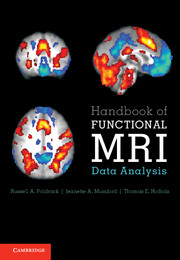Book contents
- Frontmatter
- Contents
- Preface
- 1 Introduction
- 2 Image processing basics
- 3 Preprocessing fMRI data
- 4 Spatial normalization
- 5 Statistical modeling: Single subject analysis
- 6 Statistical modeling: Group analysis
- 7 Statistical inference on images
- 8 Modeling brain connectivity
- 9 Multivoxel pattern analysis and machine learning
- 10 Visualizing, localizing, and reporting fMRI data
- Appendix A A Review of the General Linear Model
- Appendix B Data organization and management
- Appendix C Image formats
- Bibliography
- Index
2 - Image processing basics
Published online by Cambridge University Press: 01 June 2011
- Frontmatter
- Contents
- Preface
- 1 Introduction
- 2 Image processing basics
- 3 Preprocessing fMRI data
- 4 Spatial normalization
- 5 Statistical modeling: Single subject analysis
- 6 Statistical modeling: Group analysis
- 7 Statistical inference on images
- 8 Modeling brain connectivity
- 9 Multivoxel pattern analysis and machine learning
- 10 Visualizing, localizing, and reporting fMRI data
- Appendix A A Review of the General Linear Model
- Appendix B Data organization and management
- Appendix C Image formats
- Bibliography
- Index
Summary
Many of the operations that are performed on fMRI data involve transforming images. In this chapter, we provide an overview of the basic image processing operations that are important for many different aspects of fMRI data analysis.
What is an image?
At its most basic, a digital image is a matrix of numbers that correspond to spatial locations. When we view an image, we do so by representing the numbers in the image in terms of gray values (as is common for anatomical MRI images such as in Figure 2.1) or color values (as is common for statistical parametric maps). We generally refer to each element in the image as a “voxel,” which is the three-dimensional analog to a pixel. When we “process” an image, we are generally performing some kind of mathematical operation on the matrix. For example, an operation that makes the image brighter (i.e., whiter) corresponds to increasing the values in the matrix.
In a computer, images are represented as binary data, which means that the representation takes the form of ones and zeros, rather than being represented in a more familiar form such as numbers in plain text or in a spreadsheet. Larger numbers are represented by combining these ones and zeros; a more detailed description of this process is presented in Box 2.1.
Numeric formats. The most important implication of numeric representation is that information can be lost if the representation is not appropriate.
- Type
- Chapter
- Information
- Handbook of Functional MRI Data Analysis , pp. 13 - 33Publisher: Cambridge University PressPrint publication year: 2011



